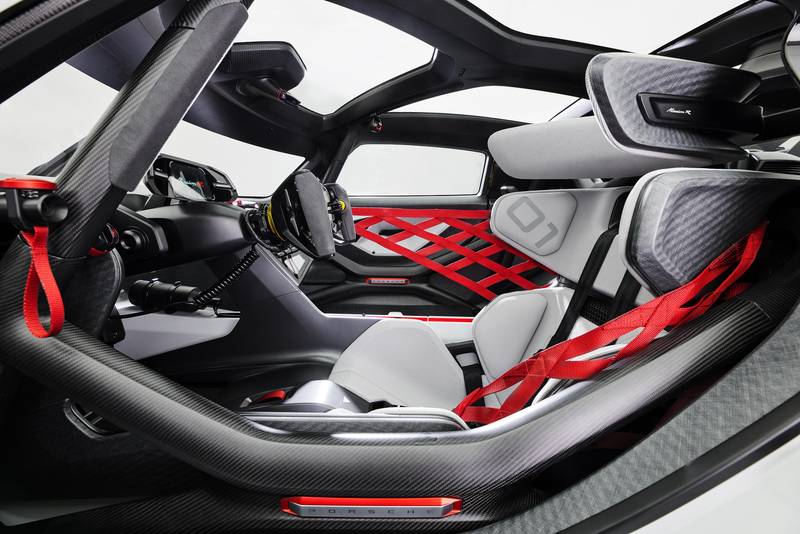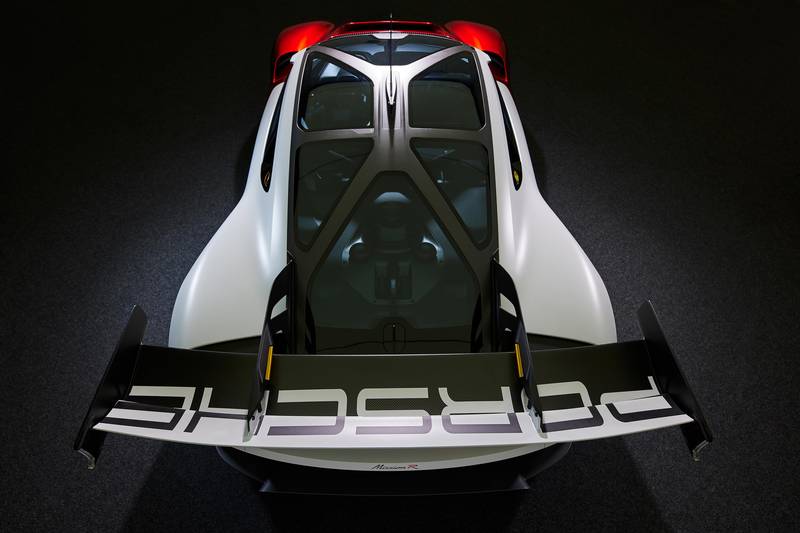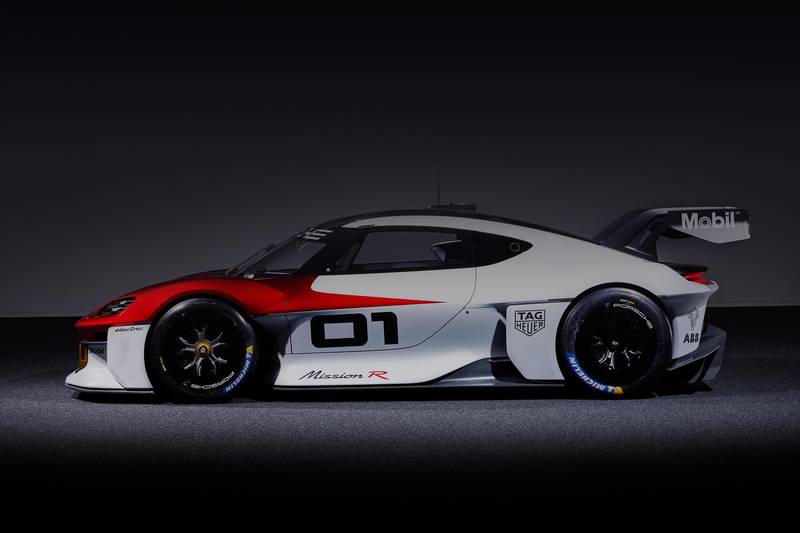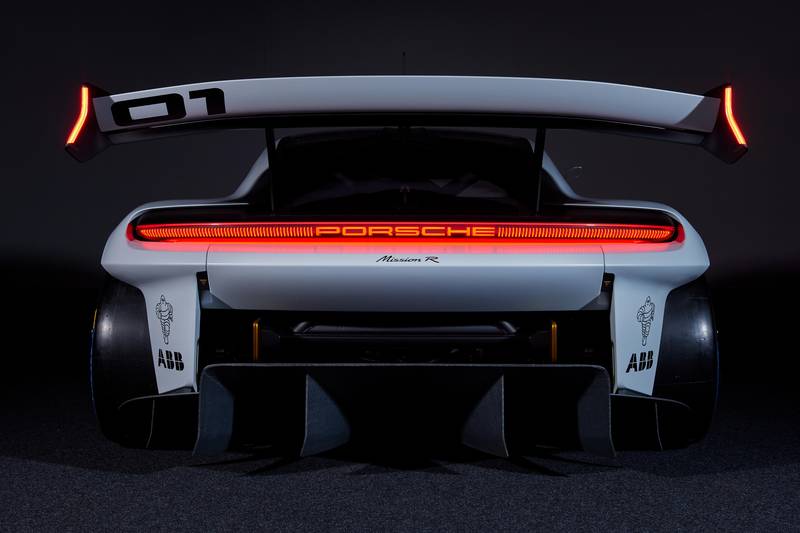Overview

Porsche claims that they are indeed the most successful brand in customer motorsport, with 30 one-make cups globally, over 4,400 911-based Cup cars manufactured to date, with 31 years of Carrera Cup racing in Germany. As a result, the folks at Zuffenhausen and Weissach are probably wondering as to what the future of customer racing using pure EV’s looks like.

The German brand clearly isn’t satisfied with Formula E. They are hence already looking ahead with the Mission R, which – on paper – looks like an electric 911 GT3 Cup car.
The Mission R could in fact go on to become the centerpiece of the Porsche single-brand cups in the not-too-distant future. The car embodies everything that makes Porsche what it is; They include attributes like Performance, Design, and in keeping with the times, Sustainability.
Bodywork with a focus on Sustainability

Upon first appearance, the concept resembles the very successful Le Mans 919 racer, although with a far more gracious-looking front and a rather stubby back. The rudiments of the Cayman floor unit are hidden under the shell. The car is 14’ long, which makes it shorter than the 718. A width of 6’6”, on the other hand, is notably more, while its height of 3’11″ is considerably lower than that car. The Mission R incorporates the most recent advances in active aerodynamics, both in the front and in the back, where a massive, two-section movable spoiler resides. The Mission R also features Porsche Active Aerodynamics (PAA) with Drag Reduction System (DRS) on the nose section as well as that giant rear wing.

Through the domed roof, a carbon-fiber superstructure visible from the outside may be viewed.
Instead of fitting a separate roll cage, this construction by itself acts as a supporting and load-bearing structure. Not only is it visually appealing, but it is also lightweight and stable, with room for an emergency exit hatch for the driver.
This robust structure also has a roof, which Porsche refers to as an exoskeleton. On top of that, body panels composed primarily of Natural Fiber Reinforced plastic (NFK) are used. Porsche uses the same material for the front splitter, diffuser, and side skirts.
“Porsche is the brand for people who fulfill their dreams. This is also true in motorsports. We experience our innovative strength on the race track, demonstrate courage in pursuing new avenues and delight car owners with sporting performance,” says Oliver Blume, Chairman of the Executive Board of Porsche AG.
A sporty Bespoke Racing Cockpit

Porsche uses NFK On the inside, as well. The material is used to make the inside door scales, the rear bulkhead, and the seat, among other things. When it comes to the interior, the driver is the focal point. All controls are easily accessible to the driver.

The cockpit is influenced by cars used in gaming simulators. A helmet holder is also in place to dry and cool the driver’s helmet using the onboard air conditioning. The car features a steering wheel that incorporates the main information screen and is linked with another unit positioned behind, which complements the first one by showing the image from the rearview cameras. A third screen, to the right of the seat, displays the driver’s biometric information.
“In addition to our involvement in the Formula E World Championship, we are now taking the next big step forward in electric mobility. The concept study is our vision of all-electric customer motorsports. The Mission R embodies everything that makes Porsche strong: performance, design and sustainability.”
The Powertrain

The Mission R features two electric motors.
The motors are derived from the Taycan, but they were further improved for motorsport to the point that they are now virtually separate designs. It comes as no surprise that Mission R’s electric drivetrain exceeds 1,000 horsepower. Two motors, one on each axle, that produces 430 horsepower at the front and 644 horsepower at the rear. The race car’s standard continuous power output remains 671 horsepower. (This is nearly the same as the upcoming hybrid LMDh Le Mans car). While in qualifying mode,
the two motors produce1085 horsepower. A Four-wheel drive system transfers tractive force to the tarmac.

Porsche has also worked on the weight distribution. The battery pack is situated ahead of the rear axle, as opposed to the Taycan. Porsche refers to this as the e-core arrangement. This layout implies that the Mission R has driving characteristics similar to those of a mid-engine racer. The Mission R’s permanently excited synchronous motors have stators that are directly tempered with oil as a coolant. Speaking of cost savings, the Mission R does away without the Taycan’s two-speed transmission; acceleration from a standstill isn’t very important in customer motorsports. Also, there’s no limit to the power that drives with only one gear. The transmission and pulse inverter on both the front and rear drives are designed identically, saving both parts and money.
Blistering Performance

The Mission R will be able to sprint from 0-60 mph in 2.5 seconds and reach speeds of over 187 mph.
The cells of the 80 kWh battery are also oil-cooled. Unlike in a typical electric motor where the coolant goes through a jacket outside the stator, the oil in direct cooling flows straight along the copper windings. More heat can be dispersed directly at the source as a result of this.
They run at 900 volts, which helps explain why the batteries can be charged from 5% to 80% in under 15 minutes during racing. Charging can be done at a rate of up to 340 kW. Such a short recharge time will enable the Mission R to confront a race weekend with free practice, qualifying, and the race without having to worry about range.
Conclusion

How exactly will motorsports evolve in the future? And how will interfaces withE-Motorsports change over time?. How plausible is this vision? Well, Porsche thinks they have an idea about where motorsports and the industry is headed.
Without a doubt, Porsche will be ready with an order book at the IAA in Munich and at the Porsche Motorsport desks. The maker has not yet stated when a probable manufacturing model will be available, but our guess would be somewhere between 2025 -2026.
You can watch Porsche reveal the Mission R below:
For GREAT deals on a new or used Hyundai check out Winn Hyundai of Santa Maria TODAY!




